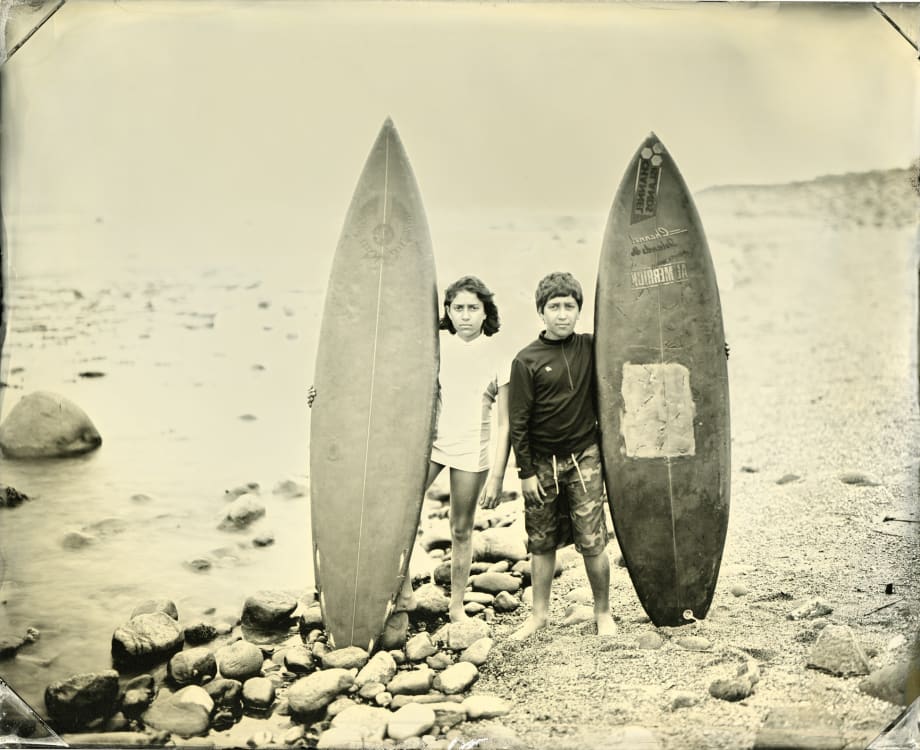Joni Sternbach: Surfland
Joni Sternbach
Ditch Plains, 2007
"We know that people are formed by the light
and air, by their inherited traits, and their actions.
We can tell from appearance the work someone does
or does not do; we can read in his face
whether he is happy or troubled," *
My pictures over recent years engage traditions of landscape, seascape, and architectural photography. Working with a large-format camera and historic process (wet-plate collodion), I have concentrated on locations that are close to or directly on the water. At this juncture between land and sea, I explore subject matter in a constant state of transition.
Joni Sternbach
Ditch Plains, 2007
"We know that people are formed by the light
and air, by their inherited traits, and their actions.
We can tell from appearance the work someone does
or does not do; we can read in his face
whether he is happy or troubled," *
My pictures over recent years engage traditions of landscape, seascape, and architectural photography. Working with a large-format camera and historic process (wet-plate collodion), I have concentrated on locations that are close to or directly on the water. At this juncture between land and sea, I explore subject matter in a constant state of transition.
For the last year I have been drawn to the people present at these locations, specifically the surfers in Montauk’s Ditch Plains, at the eastern end of Long Island. Their purpose is on the water; they are persistent elements in a shifting scene. It has been said that "when someone is surfing, they're neither here nor there; not on land nor in the ocean. They're in that indefinable space between the shadow and the light and while in it, they become one/exist in harmony with nature, with the ocean, or with simply something bigger than themselves.”* We share the landscape but not necessarily the experience. We overlap on the periphery of two powerful elements; the land and the sea. The singular, primitive act of surfing on the water is eclipsed by the social and negotiated state of human interaction on the shore. The surfers act as a bridge between the sea as an unbridled force of nature and the shore line, a place of leisure and cultural phenomena.
Working with a “wet” instantaneous process that must be prepared and developed on location serves me well. It draws spectators as well as entices new subjects. Using collodion compels me to compose carefully before sensitizing the plate, yet its very nature is spontaneous and unknowable. The raw quality of the process suits the subject matter, and the distinctive appearance of the finished works echoes nineteenth-century traditions of anthropological photography.
My approach is simple: introductions are made, and each person willing to collaborate steps into the water and poses. The sea acts as both a backdrop and a watery stage. As the tide recedes the rocky surface underneath is revealed, looking more like the moon than a beach. Photographing people at Ditch and other locations is a natural extension of my interests, exploring yet another dimension of landscape and its evolving state.
All images are one-of-a-kind 8x10” Tintypes
*August Sander from “Man of the Twentieth Century”
*Eric G. Rath, Surfer
-
 Joni Sternbach, William (Rincon), 2007
Joni Sternbach, William (Rincon), 2007 -
 Joni Sternbach, Annamarie and Richard, 2007
Joni Sternbach, Annamarie and Richard, 2007 -
 Joni Sternbach, Maud/Rincon, 2007
Joni Sternbach, Maud/Rincon, 2007 -
 Joni Sternbach, Tom (Malibu), 2007
Joni Sternbach, Tom (Malibu), 2007 -
 Joni Sternbach, Victor, 2007
Joni Sternbach, Victor, 2007 -
 Joni Sternbach, 06.09.30 #6 Minnie and Lulu, 2006
Joni Sternbach, 06.09.30 #6 Minnie and Lulu, 2006 -
 Joni Sternbach, Woody, 2007
Joni Sternbach, Woody, 2007 -
 Joni Sternbach, Ian and Ryan (Malibu), 2007
Joni Sternbach, Ian and Ryan (Malibu), 2007 -
 Joni Sternbach, Four Brothers and board, 2007
Joni Sternbach, Four Brothers and board, 2007 -
 Joni Sternbach, Kristen, 2007
Joni Sternbach, Kristen, 2007 -
 Joni Sternbach, Aaron Rochlin, 2007
Joni Sternbach, Aaron Rochlin, 2007 -
 Joni Sternbach, Naomi, 2007
Joni Sternbach, Naomi, 2007 -
 Joni Sternbach, Corey, 2007
Joni Sternbach, Corey, 2007













